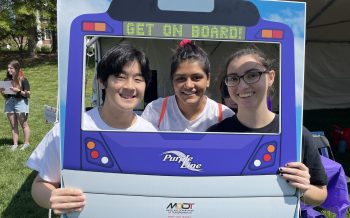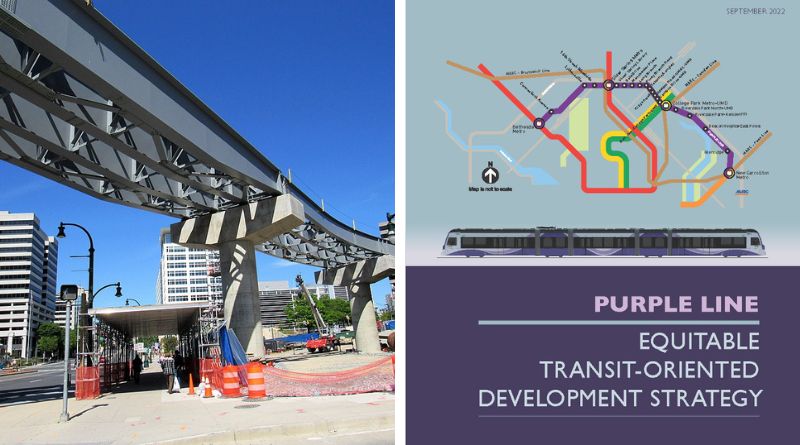National Center for Smart Growth at the University of Maryland and the Purple Line Corridor Coalition Staff. (2022)
Purple Line: Equitable Transit-Oriented Development Strategy
The Purple Line Equitable Transit-Oriented Development Strategy delves into equity considerations surrounding the construction of the Purple Line in Maryland. It presents a range of actions that policymakers can take to leverage the construction of the Purple Line to ensure greater equity through three key strategies: multi-mobility, transit-supportive development practices, and economic growth.
Currently under construction, the Purple Line is a light rail that will run east-west through Prince George’s and Montgomery Counties in Maryland. It will connect historically under-served communities with wealthy neighborhoods, starting at New Carrollton, with a median household income of $73,629, and terminating in Bethesda, with a median household income of $178,370 (American Community Survey, 2021). The disparity in incomes—combined with histories of racial inequality, redlining, disinvestment, and limited access to resources—increases the risk of further marginalizing already under-served communities along the Purple Line corridor. The Purple Line Equitable Transit-Oriented Development Strategy was developed to address these pressing concerns and ensure that the construction and operation of the Purple Line prioritizes equity and creates opportunities for all residents to benefit from improved transportation. The report is a culmination of years of collaborative work by the Purple Line Corridor Coalition (PLCC), a public-private coalition between community organizations, government representatives, nonprofits, philanthropic organizations and the business community, facilitated by the University of Maryland’s National Center for Smart Growth. Formed in 2013, the PLCC was a collective response to concerns about the potential inequities that could result from the Purple Line light rail.

The project capitalizes a unique opportunity to address long-standing disparities and promote equity through transportation investment. The Purple Line Equitable Transit-Oriented Development Strategy provides a roadmap for equitable TOD in the corridor, identifying three broader goals, providing concrete countermeasures to accomplish them, and identifying localities where these remedial measures would be most effective. It serves as an important blueprint that can guide TOD strategies not just in Maryland, but across the country. This is especially true for other states with similar commuting patterns, such as New Jersey, which is similarly situated in proximity to a major urban hub like New York City. The lessons and strategies derived from the Purple Line Equitable Transit-Oriented Development Strategy can provide valuable insights for New Jersey and other states facing similar transit challenges. Furthermore, since the Purple Line is being implemented through a public-private partnership (P3), its success can encourage similar partnerships across the country, facilitating the development of much-needed transit infrastructure across the country while allowing transit agencies to share the risks and responsibilities of large infrastructure projects.
Some important takeaways from the report include:
Encouraging multi-modal access. To ensure that the Purple Line serves the most disadvantaged populations, County Planning Departments and DOTs have to work together to encourage non-motorized modes of transportation to develop a greater set of options for mobility. They also have to ensure pedestrians’ safety by adopting traffic-calming measures, including reducing speed limits, enhancing intersection design, improving sidewalk connectivity, and upgrading existing pedestrian infrastructure. Similarly, bus service needs to be coordinated among different providers, like WMATA, Montgomery County Ride On, and Prince George’s County TheBus to increase frequency of bus service to Purple Line stations and optimize transitions between different modes of public transportation.
Transit-oriented development strategies. Transit systems can substantially increase the demand for housing and commercial properties near stations. By effectively guiding this increased demand towards transit-oriented development, numerous advantages can be realized: a decreased dependence on cars, higher ridership on public transportation, a larger tax revenue base, and more efficient land utilization. However, County Housing and Planning Departments need to address the potential risks of displacing existing households and businesses. They have to make efforts to expand affordable housing options by increasing local housing trust funds, prioritizing the Purple Line corridor for Low Income Housing Tax Credits (LIHTC) and other affordable housing programs, creating land banks for vacant properties, preserving existing affordable units and encouraging developments on underutilized public land. Expanding housing choices in Purple Line neighborhoods can also be achieved by exploring potential changes to zoning and development regulations, allowing for middle housing options like duplexes, triplexes, and small multifamily buildings in low-density areas near the Purple Line.
Economic development initiatives. A crucial aspect that demands special consideration is the preservation and creation of livelihoods. To achieve this, County Economic Development Corporations, Community Development departments and community-based organizations must provide support and assistance to existing small businesses, enabling them to navigate changing market conditions and expand their customer base. Simultaneously, they need to attract and nurture new small businesses as this can foster entrepreneurship and promote diversity in sectors like retail, restaurants, and services. The authors argue that some key industry clusters, specifically information technology and healthcare should be nurtured and expanded to generate sustained economic growth. These clusters should be leveraged to meet the needs of residents, especially people of color and immigrants, both in terms of how they serve community needs and through vocational programs to enhance residents’ skills and career paths. Finally, decision-makers must consider and address barriers to workforce participation. By implementing these strategies, communities can stimulate economic growth, create opportunities for residents, and support their diverse needs.
For more information about the Purple Line Corridor Coalition, see https://purplelinecorridor.org/

